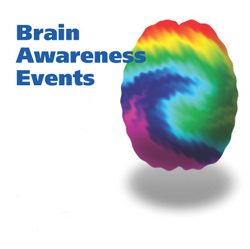
Adolescence and alcohol don’t mix: Brain Awareness lecturer
Adolescence can be emotionally wrenching, both for those living it and for those living around it. Throw alcohol into the mix and the challenges can escalate rapidly.
Synaptic changes and energy fluctuation, combined with alcohol use, can affect adolescent behavior, Linda Spear, Ph.D. told the audience at a Brain Awareness 2003 event Monday at the John F. Kennedy Center for Research on Human Development.
Spear, a Distinguished Professor of Psychology at Binghamton University, State University of New York, presented “Adolescence, Alcohol and the Brain.”
Danny G. Winder, Ph.D., assistant professor of Molecular Physiology and Biophysics, introduced Spear to the Kennedy Center audience as a “major player in neuroscience and psychology.”
Spear presented recent research, including data published from her lab, probing the effects of alcohol on the adolescent brain. The researchers surveyed an animal (rat) model of adolescence.
“The brain experiences significant physical changes during early adolescence. Widespread synaptic loss and changes in energy utilization are some of the many alterations the brain undergoes in the transition between childhood and adulthood,” said Spear. She stressed that it is these changes and not raging hormones that contribute to often-baffling adolescent behavior.
Spear said that behavioral changes associated with adolescence are similar across species, from rats to primates to humans. The effects of alcohol on this rapidly changing adolescent brain often differ from alcohol’s effects on the adult brain. In response to the question of whether the adolescent brain is more or less sensitive to alcohol, Spear said, “The answer is actually ‘both,’ but adolescents tend to be relatively insensitive to alcohol’s effects compared to adults.”
As an example, she pointed out the reduced sensitivity to acute ethanol withdrawal — the discomfort, or “hangover,” experienced after exposure to a high dose of alcohol — displayed by adolescents.
Acute ethanol withdrawal normally reduces the frequency of social interactions in adult rats when compared to un-dosed individuals. When this comparison is made in adolescent rats, no difference is observed between the acute ethanol withdrawal group and the un-dosed group. In fact, Spear said, when the social behavior of play fighting is examined, the acute withdrawal group displays a significantly greater frequency of interaction.
An area in which adolescents show greater alcohol-related sensitivity is impairment of spatial memory. Spatial memory was tested in a water-filled maze, where rats were trained to swim through the maze to a platform on which they could rest. The rats used spatial clues in the room containing the maze to navigate to the platform.
Adult and adolescent rats were trained for several days in the same maze. Some rats in both groups were given alcohol on the training days and others were not. After several days of training, spatial memory was measured by recording the distance each rat swam in order to reach the platform.
The researchers found that “alcohol administration during training did not affect performance of the adult rats: both treated and untreated animals swam approximately the same distance to the platform.” However, the alcohol-treated adolescent group swam about twice as far as the untreated adolescent animals.
“Adolescents that received their training under alcohol are impaired on this task whereas adults are not,” Spear said.
The study of alcohol’s effects on the adolescent brain has emerged largely during the last five years, according to Spear. In the future, she hopes to explore the relationship between alcohol and stress in adolescents and to examine differences between adult populations who went through adolescence with or without exposure to alcohol.
Spear’s lecture was presented by the Kennedy Center and the Vanderbilt Brain Institute as part of Brain Awareness, a monthlong program of events sponsored by the Dana Alliance for Brain Initiatives, the Society for Neuroscience, and local academic research centers across the country designed to share with the public discoveries in brain science research.













